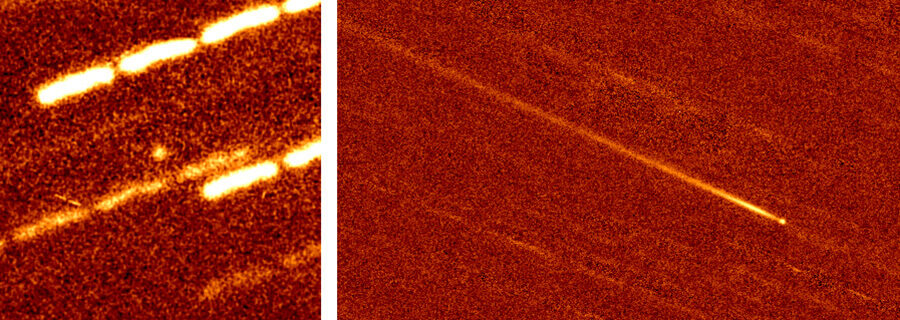
The Solar System is a dangerous place. In textbooks we see figures of celestial bodies orbiting around the Sun in orderly orbits. But that's because if an object's orbit doesn't fit this pattern, gravitational effects from other objects destabilize the orbit. One common fate for such ejected bodies is to become comets in near-Sun orbits where they will eventually plunge into the Sun. Because these comets pass so close to the Sun, they are difficult to spot and study. Most have been discovered by accident in solar telescope observations. But even taking this difficulty into account, there are far fewer near-Sun comets than expected, indicating that something is destroying them before they get a chance to make their fatal final dive into the Sun.
To better understand these comets, a group of astronomers from Macau, the US, Germany, Taiwan, and Canada observed an elusive near-Sun comet called 323P/SOHO with multiple telescopes including the Subaru Telescope, the Canada France Hawaii Telescope (CFHT), the Gemini North telescope, Lowell's Discovery Telescope, and the Hubble Space Telescope. The orbit of 323P/SOHO was poorly constrained, so the group didn't know exactly where to look for it, but the wide field of view of the Subaru Telescope allowed them to "cast a wide net" and find the comet as it approached the Sun. This was the first time 323P/SOHO was captured by a ground-based telescope. With this data, the researchers were able to better constrain the orbit, they knew where to point the other telescopes and were waiting when 323P/SOHO started to move away from the Sun again.
To their surprise the researchers found that 323P/SOHO had changed remarkably during its close passage by the Sun. In the Subaru Telescope data, 323P/SOHO was just a dot, but in follow-up data it had a long comet tail of ejected dust. The researchers believe that the intense radiation from the Sun caused parts of the comet to break off due to thermal fracturing, similar to how ice cubes crack when you pour a hot drink over them. This mass loss mechanism could help explain what happens to near-Sun comets and why there are so few of them left.
But the team's results raised more questions than they answered. They found that 323P/SOHO rotates rapidly, taking just more than half an hour per revolution, and that its color is unlike anything else in the Solar System. Observations of other near-Sun comets are needed to see if they also share these traits.
"We couldn't have made this discovery without observations from the telescopes on Maunakea, made possible by the University of Hawai'i." says Man-To Hui, who was a University of Hawai'i researcher at the time of the observations, and now an assistant professor from Macau University of Science and Technology, "The observations from the Subaru Telescope were the initiator, shrinking orbit uncertainties and making follow-up observations possible. CFHT provided the best coverage data and Gemini provided the densest data points."
These results appeared as Hui et al. "The Lingering Death of Periodic Near-Sun Comet 323P/SOHO" in the Astronomical Journal on June 14, 2022.



Reader Comments